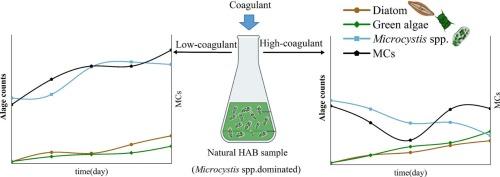残留PAC和SPFS混凝剂在有害藻华控制中的挑战和生态意义
IF 4.5
2区 生物学
Q1 BIOTECHNOLOGY & APPLIED MICROBIOLOGY
Algal Research-Biomass Biofuels and Bioproducts
Pub Date : 2025-08-19
DOI:10.1016/j.algal.2025.104272
引用次数: 0
摘要
本研究考察了微混凝剂(即处理后残留在水中的残留混凝剂)对藻华的影响,特别是在控制由蓝藻(如微囊藻)引起的有害藻华(HABs)方面。我们以聚硫酸铁钠(SPFS)和聚氯化铝(PAC)为模型混凝剂,评估了它们在不同浓度下对藻类生长、营养动态和群落结构的影响。结果表明,低浓度的混凝剂促进了微囊藻的生长和微囊藻毒素的产生,这可能是由于微量元素作为必需微量营养素,并突出了混凝剂排放的生态风险。相反,高浓度通过降低生物有效氮磷,促进营养物絮凝,促进绿藻和硅藻的生长而不是蓝藻的生长来有效抑制蓝藻的增殖。高浓度混凝剂还增加了溶解氧和pH值,进一步支持无毒藻类物种。本研究强调了混凝剂在有害藻华管理中的双重作用:高浓度的混凝剂在缓解有害藻华的同时,还需要在环境管理中进一步考虑排放到自然水体中的残留混凝剂,以防止意外的生态影响。本文章由计算机程序翻译,如有差异,请以英文原文为准。

Challenges and ecological implications of residual PAC and SPFS coagulants in harmful algal bloom control
This study examines the impact of micro-coagulants, which refer to residual coagulants remaining in the water after treatment, on algal blooms, particularly in controlling harmful algal blooms (HABs) caused by cyanobacteria such as Microcystis spp. Using sodium polyferric sulfate (SPFS) and polyaluminum chloride (PAC) as model coagulants, we evaluated their effects at varying concentrations on algal growth, nutrient dynamics, and community structure. Results revealed that low concentrations of coagulants promoted Microcystis growth and microcystin production, likely due to trace elements serving as essential micronutrients and highlighting an overlooked ecological risk of coagulant discharge. On the contrary, high concentrations effectively inhibit the proliferation of cyanobacterial by reducing bioavailable nitrogen and phosphorus, promoting nutrient flocculation, and promoting the growth of green algae and diatoms rather than cyanobacteria. High concentration coagulants also increase dissolved oxygen and pH values, further supporting non-toxic algal species. This study emphasizes the dual role of coagulants in HABs management: while high concentrations mitigate HABs, residual coagulants discharged into natural water bodies need to be further considered in environmental management to prevent unexpected ecological impacts.
求助全文
通过发布文献求助,成功后即可免费获取论文全文。
去求助
来源期刊

Algal Research-Biomass Biofuels and Bioproducts
BIOTECHNOLOGY & APPLIED MICROBIOLOGY-
CiteScore
9.40
自引率
7.80%
发文量
332
期刊介绍:
Algal Research is an international phycology journal covering all areas of emerging technologies in algae biology, biomass production, cultivation, harvesting, extraction, bioproducts, biorefinery, engineering, and econometrics. Algae is defined to include cyanobacteria, microalgae, and protists and symbionts of interest in biotechnology. The journal publishes original research and reviews for the following scope: algal biology, including but not exclusive to: phylogeny, biodiversity, molecular traits, metabolic regulation, and genetic engineering, algal cultivation, e.g. phototrophic systems, heterotrophic systems, and mixotrophic systems, algal harvesting and extraction systems, biotechnology to convert algal biomass and components into biofuels and bioproducts, e.g., nutraceuticals, pharmaceuticals, animal feed, plastics, etc. algal products and their economic assessment
 求助内容:
求助内容: 应助结果提醒方式:
应助结果提醒方式:


